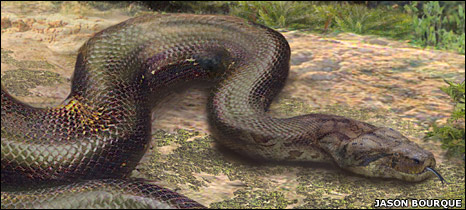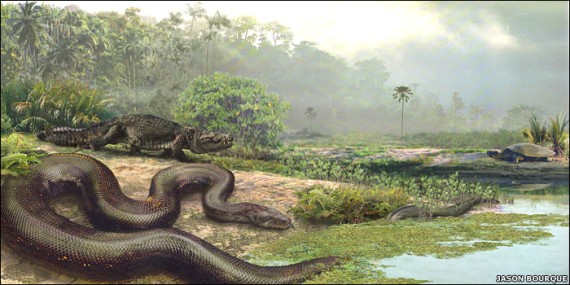By MALCOLM RITTER, AP Science Writer Malcolm Ritter, Ap Science Writer – Wed Feb 4, 6:29 pm ET
AP – A handout photo released by Nature magazine shows a Precloacal vertebra of an adult Green Anaconda (Eunectes …
NEW YORK – Never mind the 40-foot snake that menaced Jennifer Lopez in the 1997 movie “Anaconda.” Not even Hollywood could match a new discovery from the ancient world. Fossils from northeastern Colombia reveal the biggest snake ever discovered: a behemoth that stretched 42 to 45 feet long, reaching more than 2,500 pounds.
“This thing weighs more than a bison and is longer than a city bus,” enthused snake expert Jack Conrad of the American Museum of Natural History in New York, who was familiar with the find.
“It could easily eat something the size of a cow. A human would just be toast immediately.”
“If it tried to enter my office to eat me, it would have a hard time squeezing through the door,” reckoned paleontologist Jason Head of the University of Toronto Missisauga.
Actually, the beast probably munched on ancient relatives of crocodiles in its rainforest home some 58 million to 60 million years ago, he said.
Head is senior author of a report on the find in Thursday’s issue of the journal Nature.
(The same issue carries another significant report from the distant past. Scientists said they’d found the oldest known evidence of animal life, remnants of steroids produced by sponges more than 635 million years ago in Oman.)
The discoverers of the snake named it Titanoboa cerrejonensis (“ty-TAN-o-BO-ah sare-ah-HONE-en-siss”). That means “titanic boa from Cerrejon,” the region where it was found.
While related to modern boa constrictors, it behaved more like an anaconda and spent almost all its time in the water, Head said. It could slither on land as well as swim.
Conrad, who wasn’t involved in the discovery, called the find “just unbelievable…. It mocks your preconceptions about how big a snake can get.”
Titanoboa breaks the record for snake length by about 11 feet, surpassing a creature that lived about 40 million years ago in Egypt, Head said. Among living snake species, the record holder is an individual python measured at about 30 feet long, which is some 12 to 15 feet shorter than typical Titanoboas, said study co-author Jonathan Bloch.
The beast was revealed in early 2007 at the University of Florida’s Florida Museum of Natural History in Gainesville. Bones collected at a huge open-pit coal mine in Colombia were being unpacked, said Bloch, the museum’s curator of vertebrate paleontology.
Graduate students unwrapping the fossils “realized they were looking at the bones of a snake. Not only a snake, but a really big snake.”
So they quickly consulted the skeleton of a 17-foot anaconda for comparison. A backbone from that creature is about the size of a silver dollar, Bloch said, while a backbone from Titanoboa is “the size of a large Florida grapefruit.”
So far the scientists have found about 180 fossils of backbone and ribs that came from about two dozen individual snakes, and now they hope to go back to Colombia to find parts of the skull, Bloch said.
Titanoboa’s size gives clues about its environment. A snake’s size is related to how warm its environment is. The fossils suggest equatorial temperatures in its day were significantly warmer than they are now, during a time when the world as a whole was warmer. So equatorial temperatures apparently rose along with the global levels, in contrast to the competing hypothesis that they would not go up much, Head noted.
“It’s a leap” to apply the conditions of the past to modern climate change, Head said. But given that, the finding still has “some potentially scary implications for what we’re doing to the climate today,” he said.
The finding suggest the equatorial regions will warm up along with the planet, he said.
“We won’t have giant snakes, however, because we are removing most of their habitats by development and deforestation” in equatorial regions, he said.

 The discovery of fossilised remains belonging to the world’s largest snake has been reported in Nature journal.
The discovery of fossilised remains belonging to the world’s largest snake has been reported in Nature journal.
 He added that as the Earth warmed up in future, cold-blooded animals could be expected to evolved larger bodies.
He added that as the Earth warmed up in future, cold-blooded animals could be expected to evolved larger bodies.
Recent Comments